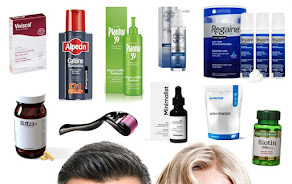Minoxidil works by widening blood vessels and increasing blood flow to the hair follicles, which can stimulate hair growth in people experiencing hair loss. It's available as a topical solution or foam that is applied directly to the scalp.
While the exact mechanism by which minoxidil promotes hair growth is not fully understood, it is believed to prolong the anagen (growth) phase of the hair follicle cycle and stimulate hair follicles that have become dormant.
Minoxidil is typically applied twice daily to the affected area of the scalp. It may take several months of regular use before noticeable results are seen, and continued use is usually necessary to maintain any hair regrowth.
It's important to note that minoxidil may not be effective for everyone, and it may not work for all types of hair loss. Additionally, like any medication, minoxidil can have side effects, some of which can be serious. It's essential to use minoxidil as directed by a healthcare professional and to report any side effects or concerns while using the medication.
Negative side-effects of minoxidil
While minoxidil is generally considered safe when used as directed, like any medication, it can have potential side effects, some of which can be serious. The most serious side effects associated with minoxidil include:
Severe Allergic Reactions
Some people may experience severe allergic reactions to minoxidil, characterized by symptoms such as rash, itching/swelling (especially of the face/tongue/throat), severe dizziness, or trouble breathing. These require immediate medical attention.
Minoxidil can sometimes cause changes in heart rate or rhythm, leading to symptoms such as chest pain, rapid heartbeat, or even fainting. These effects are more common with higher doses and in individuals with pre-existing heart conditions.
Edema
Minoxidil can cause fluid retention, leading to swelling (edema) in various parts of the body, such as the hands, ankles, or feet. In some cases, this swelling can be severe and require medical attention.
Dermatological Reactions
While minoxidil is used to promote hair growth, it can also cause skin irritation or dermatitis in some individuals, leading to symptoms such as redness, itching, or irritation at the application site.
Unwanted Hair Growth
In some cases, minoxidil may cause hair growth in unintended areas of the body where it is applied, such as the face or hands.
Interaction with Other Medications
Minoxidil can interact with other medications, particularly those used to treat high blood pressure or heart conditions, potentially leading to adverse effects or decreased effectiveness of either medication.
Weight Gain
There is limited evidence to suggest that minoxidil directly causes weight gain. However, some individuals may experience weight gain as a side effect of using minoxidil due to its potential to cause fluid retention (edema) in certain individuals.
It's important to use minoxidil as directed by a healthcare professional and to report any unusual or concerning symptoms while using the medication. If you experience any severe side effects or allergic reactions, seek medical attention immediately.
There are several alternatives to minoxidil for promoting hair growth or slowing down hair loss. Some of these alternatives include:
Safe alternatives to minoxidil
There are several alternatives to minoxidil for promoting hair growth or slowing down hair loss. Some of these alternatives include:
Nutritional Supplements
Certain vitamins, minerals, and other nutritional supplements may support hair health and growth. For example, biotin, vitamin D, iron, zinc, and omega-3 fatty acids are all important nutrients for maintaining healthy hair follicles.
Low-Level Laser Therapy (LLLT)
LLLT involves exposing the scalp to low-level laser light to stimulate hair follicles and promote hair growth. LLLT devices are available for home use, including handheld devices, helmets, and caps. LLLT is considered safe and non-invasive, and it may help improve hair density and thickness in people with androgenetic alopecia.
Keratinocyte Growth Factor (KGF) Serum
Keratinocyte Growth Factor (KGF), also known as Fibroblast Growth Factor 7 (FGF-7), is a protein that plays a role in the growth and development of epithelial tissues, including the skin and hair follicles. Research suggests that KGF may have potential applications in promoting hair growth and improving hair follicle function.
Serums containing KGF are marketed as potential treatments for hair loss or to improve hair health. These serums typically claim to stimulate hair follicles, promote hair growth, and improve the overall quality of the hair.
Serums containing KGF are marketed as potential treatments for hair loss or to improve hair health. These serums typically claim to stimulate hair follicles, promote hair growth, and improve the overall quality of the hair.
Saw Palmetto Shampoo
Saw palmetto is a plant extract that is sometimes used in hair care products, including shampoos, for its potential to promote hair growth and prevent hair loss. Saw palmetto is believed to work by inhibiting the enzyme 5-alpha-reductase, which converts testosterone into dihydrotestosterone (DHT), a hormone that can contribute to hair loss in people with androgenetic alopecia .
Rosemary Oil
Rosemary oil is a popular natural remedy that is sometimes used to promote hair growth and improve hair health. It is extracted from the leaves of the rosemary plant (Rosmarinus officinalis) and has a long history of use in traditional medicine for various purposes, including hair care.
Ad.










Post a Comment